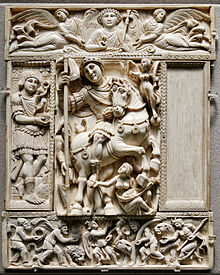
Back Laat Oudheid Afrikaans Spätantike ALS عصور قديمة متأخرة Arabic Antigüedá tardía AST Son qədim dövr Azerbaijani Позняя Антычнасць Byelorussian Късна античност Bulgarian Antiguitat tardana Catalan Pozdní antika Czech Senantikken Danish
This article needs additional citations for verification. (April 2024) |

Late antiquity is sometimes defined as spanning from the end of classical antiquity to the local start of the Middle Ages, from around the late 3rd century up to the 7th or 8th century in Europe and adjacent areas bordering the Mediterranean Basin depending on location.[1] The popularisation of this periodization in English has generally been credited to historian Peter Brown, who proposed a period between 150 and 750 AD.[2] The Oxford Centre for Late Antiquity defines it as "the period between approximately 250 and 750 AD".[3] Precise boundaries for the period are a continuing matter of debate. In the West, its end was earlier, with the start of the Early Middle Ages typically placed in the 6th century, or even earlier on the edges of the Western Roman Empire.[citation needed]
- ^ Gaudio, Andrew. "Research Guides: Late Antiquity: A Resource Guide: Introduction". guides.loc.gov. Archived from the original on 2023-11-05. Retrieved 2024-08-13.
- ^ The World of Late Antiquity (1971)
- ^ "Home". www.ocla.ox.ac.uk. Archived from the original on 2024-01-24. Retrieved 2024-08-13.